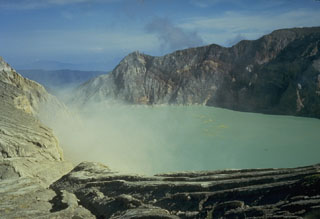Report on Ijen (Indonesia) — 4 January-10 January 2023
Smithsonian Institution / US Geological Survey
Weekly Volcanic Activity Report, 4 January-10 January 2023
Managing Editor: Sally Sennert.
Please cite this report as:
Global Volcanism Program, 2023. Report on Ijen (Indonesia) (Sennert, S, ed.). Weekly Volcanic Activity Report, 4 January-10 January 2023. Smithsonian Institution and US Geological Survey.
Ijen
Indonesia
8.058°S, 114.242°E; summit elev. 2769 m
All times are local (unless otherwise noted)
PVMBG reported that beginning in July 2022 the seismic network at Ijen began detecting increasing numbers of shallow volcanic earthquakes and earthquake signals characteristic of emissions, indicating increasing pressure at shallow depths within the hydrothermal system. The number of shallow volcanic earthquakes again increased on 1 January. The temperature of the crater lake water rose from 16 degrees Celsius in December 2022 to 45.6 degrees Celsius on 5 January 2023. During a field visit on 5 January scientists noted that the color of the lake water was light green, dense white solfatara plumes were visible rising from vents, and the sulfur odor was strong. Increased activity at the volcano is often characterized by a change in the lake water color from green to whitish-green due to the resuspension of disturbed lake-bottom sediments from increased gas emissions. The elevated unrest promoted PVMBG to raise the Alert Level to 2 (on a scale of 1-4) on 7 January. Residents, visitors, and miners were advised to not approach the crater within 1.5 km.
Geological Summary. The Ijen volcano complex at the eastern end of Java consists of a group of small stratovolcanoes constructed within the 20-km-wide Ijen (Kendeng) caldera. The north caldera wall forms a prominent arcuate ridge, but elsewhere the rim was buried by post-caldera volcanoes, including Gunung Merapi, which forms the high point of the complex. Immediately west of the Gunung Merapi stratovolcano is the historically active Kawah Ijen crater, which contains a nearly 1-km-wide, turquoise-colored, acid lake. Kawah Ijen is the site of a labor-intensive mining operation in which baskets of sulfur are hand-carried from the crater floor. Many other post-caldera cones and craters are located within the caldera or along its rim. The largest concentration of cones forms an E-W zone across the southern side of the caldera. Coffee plantations cover much of the caldera floor; nearby waterfalls and hot springs are tourist destinations.
Source: Pusat Vulkanologi dan Mitigasi Bencana Geologi (PVMBG, also known as CVGHM)

